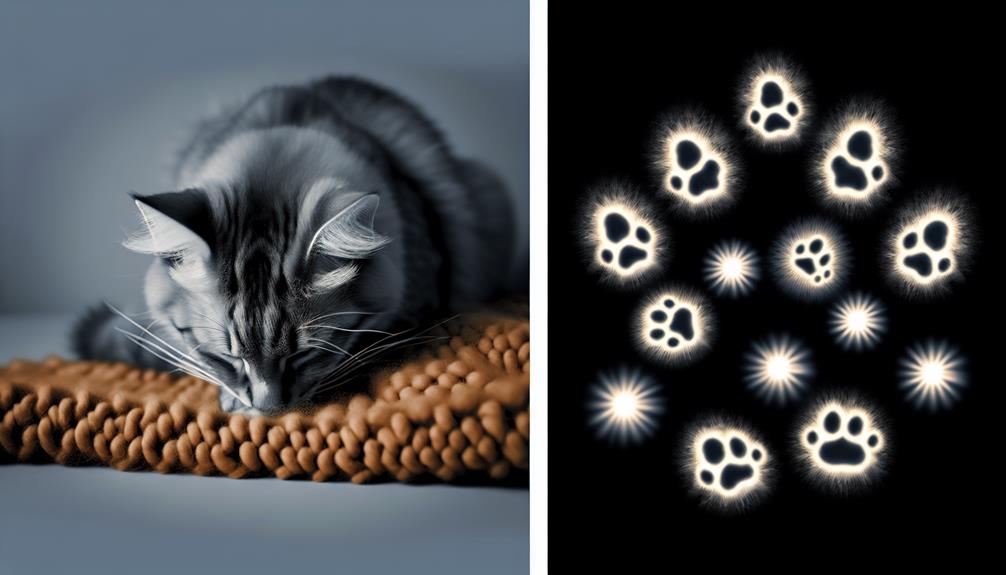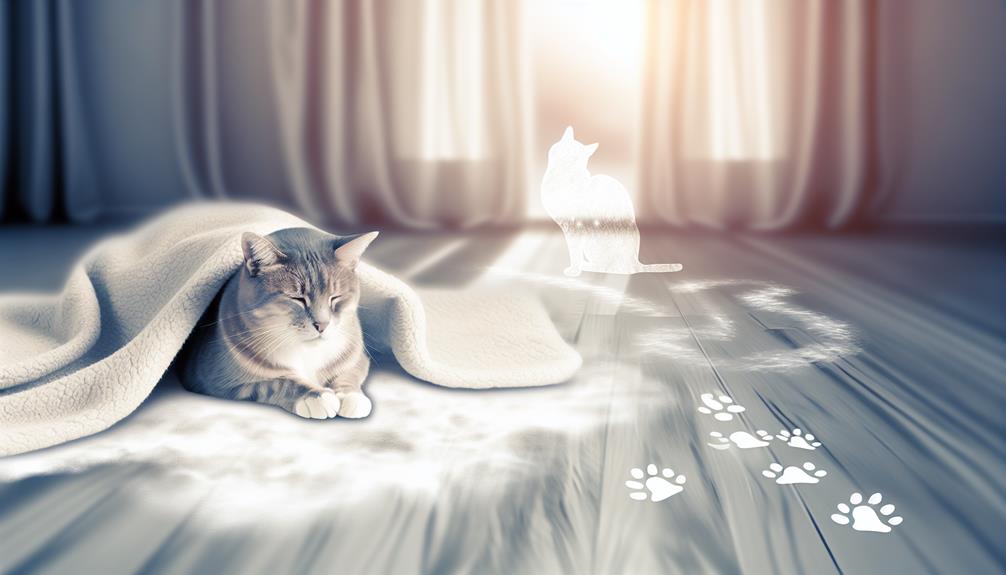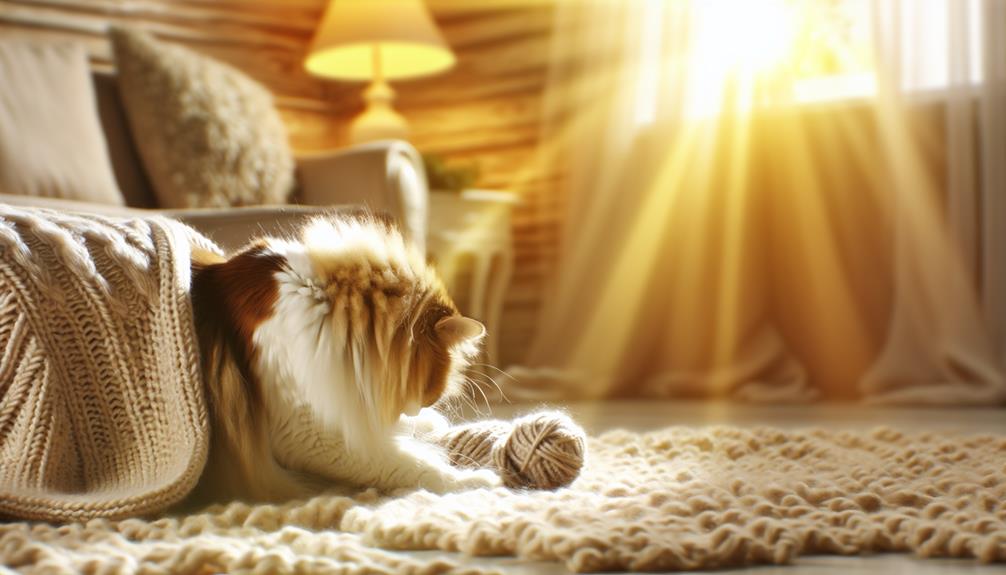You might think that your cat's kneading behavior is just a quirky habit, but there's more to it than meets the eye. This seemingly odd action is deeply rooted in their kittenhood experiences and serves multiple purposes that you might find fascinating. From providing comfort and security to marking their territory, cats knead for reasons that enrich their emotional and physical well-being. Plus, this behavior can even strengthen the bond between you and your feline friend. Curious about the intricate details behind this behavior? Let's explore the various aspects that make kneading such an essential part of a cat's life.
Kittenhood Nursing Instincts
From their earliest days, kittens exhibit a particular behavior known as kneading, which appears to stem from instinctual actions performed during nursing. This behavior, characterized by the rhythmic pressing of their paws against a soft surface, is closely linked to their nursing habits. When kittens are nursing, they knead their mother's mammary glands to stimulate milk flow, an action that is both reflexive and critical for their survival.
You'll notice that this kneading behavior persists even after the kitten has weaned. Scientifically, this can be attributed to the formation of neural pathways during the early stages of development. These neural pathways are reinforced by the repeated action of kneading, effectively embedding this behavior into the kitten's repertoire. It's a classic example of a fixed action pattern, a sequence of instinctive behaviors performed in response to specific stimuli.
Moreover, the biochemical underpinnings of this behavior are also significant. The act of kneading likely triggers the release of endorphins, which are neurotransmitters associated with pleasure and pain relief. This release creates a positive feedback loop, encouraging the kitten to continue the behavior.
From an evolutionary perspective, retaining kneading actions into adulthood could offer certain adaptive advantages. For example, the same neural circuits that govern nursing habits might also facilitate other behaviors essential for survival, such as grooming or nest-building.
Understanding kitten behavior, particularly kneading, provides valuable insights into the broader scope of feline behavioral patterns. By recognizing the roots of these actions in nursing habits, you can better appreciate the complex interplay of instinct and learned behavior in your feline companions.
Comfort and Security
While the origins of kneading can be traced back to kittenhood nursing instincts, this behavior serves additional functions as cats mature. One significant aspect of kneading is its role in providing comfort and security to adult cats. This behavior often coincides with purring, indicating a state of contentment. The purring relationship in this situation is not just incidental but a vital marker of a feline's emotional wellbeing. When your cat kneads, it is likely experiencing a calming effect, akin to a human engaging in repetitive, soothing activities like knitting or rocking.
Scientific studies on feline behavior suggest that kneading activates neurochemical pathways that are associated with relaxation and stress reduction. The rhythmic motion and tactile sensation of pressing against a soft surface likely stimulate the release of endorphins, contributing to a sense of tranquility. Additionally, the presence of familiar scents on the kneaded surface can intensify this feeling of security, reinforcing the behavior.
From an ethological perspective, the act of kneading can be viewed as a displacement activity—a behavior that arises in situations where an animal experiences conflicting motivations. For example, a cat might knead when it's feeling both affectionate and slightly anxious, thereby using the behavior to self-soothe. The repetitive nature of kneading provides a predictable routine, which can be particularly comforting in unfamiliar or stressful environments.
In essence, kneading serves as a multifaceted behavior that not only harks back to early developmental stages but also plays a significant role in an adult cat's ability to manage stress and maintain emotional stability. Understanding this behavior enriches the human-feline bond, highlighting the importance of providing environments where cats can engage in such comforting activities.
Territory Marking

When cats engage in kneading, they're not just seeking comfort but also marking their territory. This behavior, often mistaken as merely a sign of contentment, serves a critical function in territorial signaling. Cats possess scent glands in their paw pads, which release pheromones during kneading. By pressing their paws into surfaces, they deposit these chemical markers, effectively claiming the area as their own.
| Behavior | Purpose |
|---|---|
| Kneading | Comfort & Territory Marking |
| Scratching | Territory Marking |
| Head Rubbing | Scent Marking |
| Urine Spraying | Boundary Establishment |
The presence of these scent glands guarantees that the pheromones spread through kneading carry unique chemical signatures. These signatures convey information about the cat's identity and emotional state, making them a sophisticated form of intra-species communication. When your cat kneads on your lap or favorite blanket, they're not just enjoying a soothing activity; they're also embedding their scent to create a familiar and secure environment.
Scientific studies have shown that these scent markers play a pivotal role in social structures within feline populations. The deposited pheromones act as a non-verbal communication tool, reducing the likelihood of conflicts by delineating clear territorial boundaries.
It's essential to recognize that kneading is more than a simple, comforting action. It is an intricate behavior rooted in evolutionary biology, driven by the need for territorial signaling. The scent glands in your cat's paws allow them to leave a lasting impression, not just on their favorite napping spots but also in the social fabric of their feline interactions. Understanding this multifaceted behavior will give you deeper insights into your cat's complex world.
Stretching Muscles
When observing your cat knead, you're witnessing an activity that enhances muscle flexibility and maintains overall physical health. This behavior is rooted in natural instincts that promote muscular stretching, essential for their agility and mobility. Scientific studies show that this action helps maintain ideal muscle tone and joint function.
Muscle Flexibility Benefits
Kneading behavior in cats contributes considerably to their muscle flexibility by stretching various muscle groups. This activity engages both superficial and deep muscle layers, promoting muscle recovery and maintaining joint health. By systematically extending and contracting different muscle fibers, kneading facilitates enhanced blood circulation. This improved blood flow is vital for delivering oxygen and essential nutrients to muscle tissues, which aids in their repair and recovery after periods of inactivity or strenuous movements.
Furthermore, the rhythmic motion of kneading acts as a low-impact exercise for the joints. Regular movement of the joints helps maintain their lubrication and flexibility, reducing the risk of stiffness and degenerative joint issues such as arthritis. Through this repetitive action, cats can preserve the integrity of their musculoskeletal system, ensuring their agility and physical well-being.
Clinical studies have demonstrated that regular stretching activities, such as kneading, can have significant benefits on overall muscle tone and endurance. Stretching helps alleviate muscle tension, reduces the likelihood of muscle strains, and enhances flexibility. Thus, observing your cat's kneading behavior isn't just a quirky habit but an essential practice for their musculoskeletal health.
Natural Instincts Display
A cat's kneading behavior can be traced back to their natural instincts, particularly those related to muscle stretching. This action is not merely recreational; it serves a crucial function in maintaining your cat's musculoskeletal health. When they press their paws rhythmically into soft surfaces, they engage in a form of stretching that helps elongate their muscles and keep them supple. Coupled with purring rhythms, this activity also has a soothing effect on the cat, promoting relaxation and reducing stress levels.
The act of kneading can be broken down into several components, each with its own specific benefits:
| Component | Function | Benefit |
|---|---|---|
| Muscle Engagement | Activates various muscle groups | Enhances flexibility and strength |
| Purring Rhythms | Provides auditory feedback | Reduces stress and anxiety |
| Soft Surfaces | Offers resistance | Promotes comfort and satisfaction |
| Repetitive Motion | Guarantees sustained activity | Maintains muscle tone |
Evidence suggests that these behaviors are deeply ingrained and serve as a natural method for cats to maintain their physical well-being. By understanding the clinical significance of kneading, you can better appreciate this seemingly simple yet profoundly important instinctual behavior in your feline companions.
Mating Behavior

In the context of mating behavior, you'll find that kneading can be linked to reproductive instincts activation. Hormonal influence patterns often play a significant role, affecting both male and female cats. Additionally, kneading might serve as a mechanism for territory marking signals, essential during mating periods.
Reproductive Instincts Activation
Observing a cat's kneading behavior, one might wonder how it connects to their reproductive instincts. Kneading is not merely a comfort-seeking action; it can also be linked to mating rituals and reproductive behaviors. Female cats, or queens, often exhibit kneading behavior when they are in estrus. This action may signal readiness for mating, as it can help release pheromones from the scent glands located in their paw pads.
Key Points:
- Estrus Period: During this phase, female cats knead more frequently, aligning with other reproductive behaviors such as increased vocalization and restlessness.
- Pheromone Release: Kneading aids in the release of pheromones, which are essential for attracting male cats and initiating mating rituals.
- Comfort and Security: The act of kneading can create a sense of comfort, which may reduce stress levels, indirectly supporting reproductive success.
Understanding these connections provides insight into the multifaceted nature of feline kneading. While often observed in domestic settings, this behavior has deep-rooted evolutionary purposes. Recognizing these reproductive instinct activations helps in comprehending not just the physical actions, but also the underlying hormonal and behavioral triggers that guide feline mating practices.
Hormonal Influence Patterns
Kneading behaviors in cats aren't solely influenced by external actions but are also profoundly affected by hormonal fluctuations. As a cat enters different phases of its reproductive cycle, hormonal changes can greatly modulate feline behavior. For instance, increases in estrogen and progesterone levels during estrus can heighten a female cat's kneading activity, possibly as a signaling mechanism to potential mates.
| Hormone | Phase of Cycle | Behavioral Influence |
|---|---|---|
| Estrogen | Estrus | Increased kneading activity |
| Progesterone | Luteal phase | Decreased activity |
| Testosterone | Male behavior | Aggressive kneading |
These hormonal fluctuations intricately link to mating behaviors, making kneading a multifaceted action. In male cats, testosterone surges can lead to more assertive kneading, often coupled with other mating displays. Understanding these patterns requires a clinical approach, analyzing hormonal assays alongside behavioral observations.
You might notice that your cat's kneading frequency varies, particularly if they are unspayed or unneutered, correlating with their reproductive status. By recognizing these hormonal influence patterns, you can better comprehend the underlying motivations in your feline companion's actions, leading to more informed caregiving and behavioral management strategies.
Territory Marking Signals
When examining feline territory marking signals, it is crucial to recognize how these behaviors intertwine with mating activities. Cats utilize their scent glands, which are located in various parts of their body, to leave pheromonal markers. These markers play a critical role in feline communication, particularly during mating seasons. Understanding these signals can help you interpret your cat's actions more accurately.
Key Points to Reflect On:
- Scent Marking: Cats have scent glands located on their cheeks, paws, and the base of their tail. When they rub or knead surfaces, they deposit pheromones that communicate their presence and reproductive status to other cats.
- Behavioral Cues: Kneading is often accompanied by other mating behaviors such as vocalizations and body postures. These behaviors collectively function to attract potential mates and establish territory.
- Territorial Boundaries: Scent marking through kneading serves to delineate a cat's territory. This not only keeps intruders at bay but also signals to potential mates that the area is occupied by a fertile individual.
Expression of Affection
The phenomenon of feline kneading often serves as an expression of affection, demonstrating a complex interplay of behavioral and neurological factors. When your cat engages in kneading, it's typically accompanied by purring sounds, a well-documented indicator of feline contentment and relaxation. This combination of actions is a clear manifestation of bonding behavior. The cat's repetitive motion, pressing its paws alternately against a soft surface, often correlates with a heightened state of comfort and attachment to either an object or person.
Neurologically, this behavior is believed to originate from the cat's early developmental stages. Kittens knead their mothers' mammary glands to stimulate milk flow, a primal action that becomes ingrained in their behavioral repertoire. This early association between kneading and a sense of security and nourishment likely persists into adulthood. Consequently, when an adult cat kneads, it is often an implicit expression of trust and affection towards the recipient, whether it be another animal, a human, or even a favored blanket.
Clinically, the act of kneading can be seen as a form of positive reinforcement in the human-animal bond. The tactile stimulation provided by kneading can release endorphins, fostering a soothing effect on the cat, while simultaneously reinforcing the bond with the human who often responds with petting or verbal affirmations. This mutual interaction not only strengthens the emotional connection but also supports the cat's overall well-being.
Conclusion
To sum up, understanding why cats knead enhances your bond with them. Rooted in kittenhood nursing instincts, kneading provides comfort, security, and marks territory through scent glands. This behavior also promotes muscle engagement, essential for flexibility, and may even be linked to mating behavior. Remember, "old habits die hard," and kneading remains a multifaceted expression of your cat's affection and well-being. Recognizing these behaviors allows you to better appreciate and respond to their needs.
